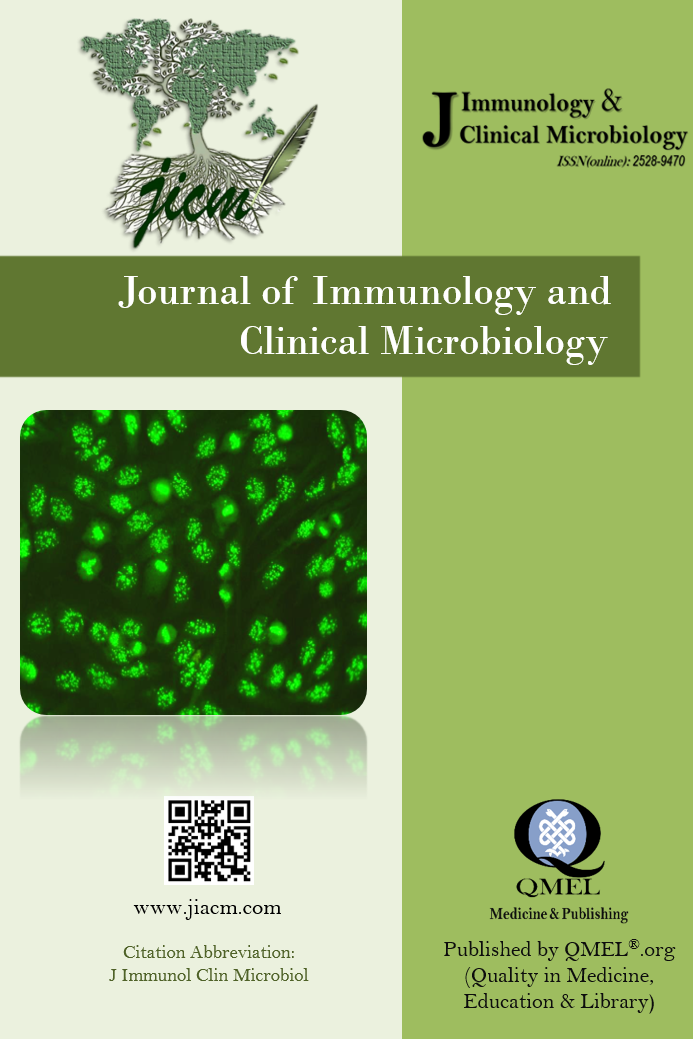Distribution of the patterns in patients with positive antinuclear antibody and anti-extractable nuclear antigen
Distribution of the patterns in patients with positive antinuclear antibody and anti-extractable nuclear antigen
Background: Early diagnosis of autoimmune disorders is critical in order to prevent complications, morbidity and mortality. Antinuclear antibody (ANA) tests are commonly used in support of the diagnosis of autoimmune diseases. In the present study, we aimed to compare and evaluate the ANA patterns which were determined via an IFA method for the detection of the presence of autoantibody against extractable nuclear antigens (ENA). Material and Methods: Antinuclear antibodies were tested for a total of 5453 patients admitted to various clinics of Ondokuz Mayıs University Medical Faculty. A 1:100 dilution of each serum sample was used, and the presence of ANA and staining pattern was evaluated with ANA-IFA. A total of 616 ANA-positive samples were also tested for anti-ENA using the same method. Results: ANA tests were detected as positive in 843 samples (15.5%). Amongst patients, 624 (74%) were female, and 219 (26%) were male. Anti-ENA antibodies were positive for 192 (31.2%) of 616 which are positive for ANA and of which anti-ENA was sought. Of those, the most common-ANA patterns were detected as speckled in 144 (75.0%) samples, nucleolar in 20 (10.4%), and homogeneous in 13 (6.8%) samples. The most common anti-ENA antibodies were found to be anti-SS-A in 50 samples (26.0%), RO-52 in 39 (20.3%), and anti-scl-70 in 34 (17.7%) samples. Conclusion: Findings of the present study suggested that anti-ENA antibodies do not follow a specific ANA pattern an ANA pattern isn’t related to a specific anti-ENA antibody type. However, the presence of various ANA patterns may sometimes be associated with a specific disease or a syndrome. Detection of antinuclear antibodies, determination of the ANA patterns and, assessment of different ENA antibody types and interpretation of the results altogether will help the clinician significantly in the diagnosis of autoimmune diseases.
___
- Hu J, Meng W, Zhang D, Qiu C, Hua L, Xie Q, et al. Th17-relevant cytokines vary with sera of different ANA staining patterns. Int Immunopharmacol 2013; 15: 679-684.
- Satoh M, Vázquez-Del Mercado M, Chan EK. Clinical interpretation of antinuclear antibody tests in systemic rheumatic diseases. Mod Rheumatol 2009; 19: 219-228.
- Zafrir Y, Gilburd B, Carrasco MG, Kivity S, Sánchez-Castañón M, López-Hoyos M, et al. Evaluation of an automated chemiluminescent immunoassay kit for antinuclear antibodies in autoimmune diseases. Immunol Res 2013; 56: 451-456.
- Avery TY, Cruys MVD, Austen J, Stals F, Damoiseaux JGMC. Anti-nuclear antibodies in daily clinical practice: prevalence in primary, secondary, and tertiary care. Journal of immunology research 2014;1-8 doi.org/10.1155/2014/401739
- Almeida González D, Cabrera de León A, Rodríguez Pérez Mdel C, Brito Díaz B, González Hernández A, García García D, et al. Efficiency of different strategies to detect autoantibodies to extractable nuclear antigens. J Immunol Methods 2010; 360: 89-95.
- Egner W. The use of laboratory tests in the diagnosis of SLE. Clin Pathol 2000; 53: 424-432.
- Yayın Aralığı: Yılda 4 Sayı
- Başlangıç: 2016
- Yayıncı: Erkan YULA
